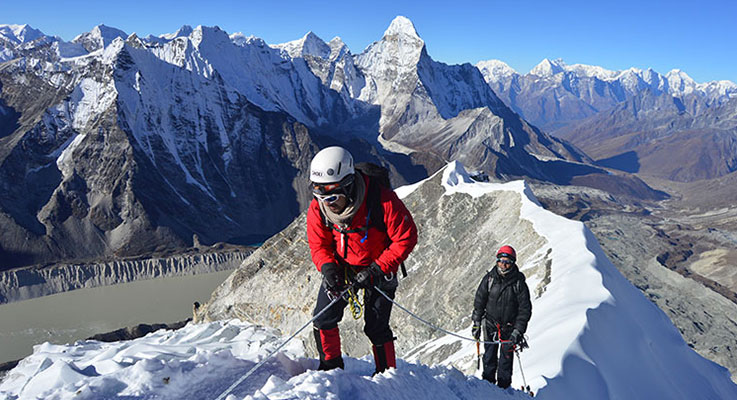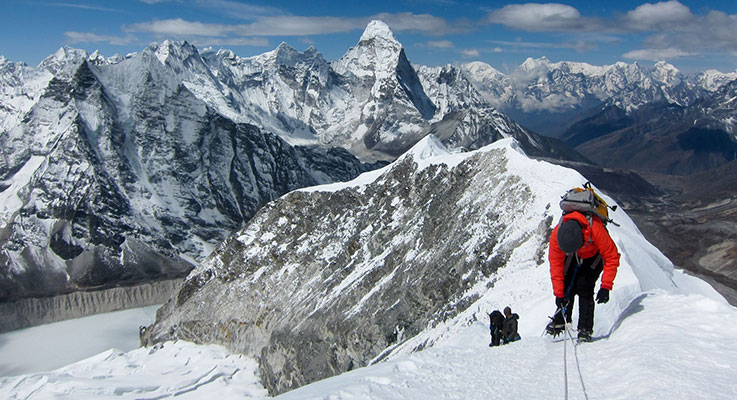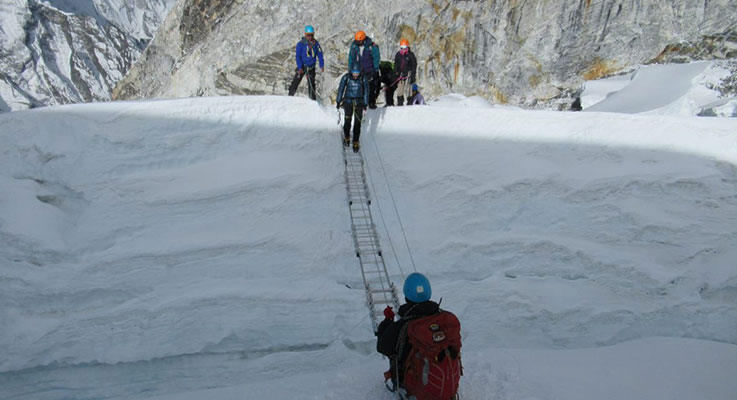-
Day 1
Arrival in Kathmandu (1,345m/4,413 ft)
Upon arriving at Tribhuwan International Airport in Kathmandu, you will be received by our airport representatives who will warmly greet you and transfer to the hotel on a private tourist vehicle. We provide 3-star accommodation in the city and we arrange for a trip briefing with dinner in the evening.
-
Day 2
Visit old town of Kathmandu
A professional guide and vehicle are provided for a day of sightseeing in and around Kathmandu city. We visit some of the UNESCO World Heritage Sites in the city along with other interesting cultural monuments that dot the valley. These include Boudhanath Stupa (the largest Buddhist shrines in the world), Pashupatinath (the holiest Hindu temple in the world), Durbar Squares (Palaces and fortresses of medieval Kings), along with other popular cultural attractions. We get to observe the lifestyle of Nepalese people, holy sadhus and monks, fascinating history as well as awe-inspiring architecture.
-
Day 3
Fly from Kathmandu to Lukla (2,800m/9,186 ft). Trek to Phakding (2,610m/8,563 ft)
Early in the morning, you will be transferred to the airport in Kathmandu for a scenic 30-minute flight to Lukla. The airport guide will brief you and introduce our porters before we begin our trek towards Phakding (2,610m). There will be some time to explore the village while our Sherpa crew sorts and loads trekking equipment and baggage. The trek starts with a descent to DudhKosi River, from where the wider trail leads us to the village of Ghat (2,550m), and then to Phakding on an easy-paced walk.
-
Day 4
Trek from Phakding to Namche Bazar (3,440m/11,286 ft)
Walking along the shores of Dudh Kosi, we get to cross the serene river many times on exhilarating suspension bridges decorated with prayer flags. A little further, we enter Sagarmatha National Park from where the trail climbs steeply with picturesque sights. After trekking for a few hours, we reach Namche Bazaar, known as the Gateway of Everest.
-
Day 5
Namche Bazaar acclimatization day
In order to acclimatize to the altitude gained and thinner air, we spend a day in Namche Bazaar. There are several quality restaurants, hotels, lodges, shops, money exchange services, internet cafes and bakeries at this town, also the largest in the Everest region. We pay a visit to the museum nearby known for its traditional artefacts that showcase the Sherpa culture. We also hike to Syangboche Airport from where we can see rewarding vistas of stunning sunrise and sunset over the Himalayan panorama.
-
Day 6
Trek from Namche Bazaar to Deboche (3,800m / 12,467ft)
We ascend out of the village and follow a high, fairly level path above the DudhKosi enjoying spectacular mountain views of Everest, Nuptse and Lhotse as we go. We pass the various shops set up by Tibetans selling trinkets and then descend through forest of blue pine to cross the DudhKosi again at Phunki (3,250m). We make another ascent on a switchback trail, sometimes made quite dusty by yak trains, to reach the spectacularly sited Thyangboche Monastery (3,867m) from where there are brilliant views of Everest, Lhotse, Nuptse, AmaDablam and Taboche to the north and northeast, Thamserku and Kantega to the southeast and Kwangde to the southwest. Thyangboche Monastery was seriously damaged by fire in 1989 but has since been rebuilt and there will be time to visit both the monasteries and a museum. We reach our teahouse at Deboche. 6 hours walk.
-
Day 7
Trek from Deboche to Dingboche (4,350m/14,272 ft)
Cross a large open meadow and descend through a forest of birches, conifers and rhododendron to cross the ImjaKhola. The trail now climbs up past some magnificently carved Mani walls to Pangboche Monastery 3900m, the oldest monastery in the region. Our route now takes us beyond the tree line. Much of the vegetation is scrub juniper, tundra and windflowers. Pass several yak herders’ huts and climb over a small ridge before crossing the KhumbuKhola and ascending to Pheriche.
-
Day 8
Dingboche acclimatization day
A day for acclimatization and exploring: you can do a day’s walk up the ImjaKhola valley through Bibre at 5060m to the yak huts at Chukhung. Here are good views of the east face of AmaDablam and the Lhotse-Nuptse wall. Or you can walk north, up along the valley side to the ruined NangkartshangGompa, or continue up to nearby Nangkartshang peak with its fantastic views. 5 hours walk.
-
Day 9
Trek from Dingboche to Chukhung (4,710m/15,453 ft), back to Dingboche
From Pheriche we proceed northwest across the flat floor of the valley draining the Tshola and Khumbu glaciers. The stone walled fields of Pheriche are the last we pass. After two miles we turn right and start to climb the terminal moraine of the Khumbu glaciers. At lunchtime we reach Dhugla. From Dhugla the track climbs over the gargantuan chaos of the Khumbu Glacier’s moraine. Eventually, it takes us to the left of the glacier and to the huts at Lobuche.
-
Day 10
Trek from Lobuche to Gorakshep (5,180m/16,995 ft) via Kala Patthar (5,555m/18,225 ft)
It is a 6am start for those who wish to ascend Kalapathar. Gentle walk initially, then ascend after about an hour and cross the moraine. Descend to the expanse of the GorakShep (5,160m). A two hours steep ascend brings us to the top of Kalapathar. From Kalapathar descend to GorakShep and spend the night there.
-
Day 11
Trek from Gorakshep to Lobuche (4,910m/16,109 ft) via Everest Base Camp (5,365m/17,602 ft)
From GorakShep, it may be possible to make an excursion in the direction of the Base Camp area, depending on group fitness. Though of interest, this trip is not as spectacular as the ascent of Kalapathar as there are no views of Everest but there is a possibility of meeting/visiting famous climbers and their camps. Return to Lobuche.
-
Day 12
Trek from Lobuche to Dingboche (4,350m/14,272 ft)
Return from Lobuche to Dughla and then, taking a different trail, stay with above the valley floor before descending steeply to DingbocheAfter Lunch continue up the valley to reach Chhukhung in about two hours and rest at Chhukhung.
-
Day 13
Trek from Dingboche to Chhukung (4,710m/15,453 ft)
After Breakfast continue up the valley to reach Chhukhung in about two hours and rest at Chhukhung.
-
Day 14
Trek from Chhukung to Imja Tse (Island Peak) Base Camp (5,240m/17,192 ft)
-
Day 15
Trek from Imja Tse Base Camp to High camp or training at Base Camp
-
Day 16
Ascend to Imja Tse (6,189m/20,305 ft) and back to Imja Tse Base Camp
-
Day 17
Extra day at Imja Tse Base Camp in case of bad weather
-
Day 18
Trek from Imja Tse Base Camp to Tengboche (3,860m/12,664 ft)
Walk down the Imja valley to Tengboche.
-
Day 19
Trek from Tengboche to Monzo (2,825m/9,268 ft)
From Tengboche via Namche Bazaar to Monzo.
-
Day 20
Trek from Monzo to Lukla (2,800m/9,186 ft)
We continue on down Dudh Koshi for lunch at Ghat, or to Lukla.
-
Day 21
Fly from Lukla to Kathmandu (1,345m/4,413 ft)
Today we fly back to Kathmandu from Lukla, and during your flight you can enjoy some last-minute glimpses of the mountains. Upon arrival in Kathmandu, you can rest, relax and go sightseeing throughout the day.
-
Day 22
Leisure day in Kathmandu
This is a leisure and free day in Kathmandu for exploration. You are free to go souvenir shopping, spa and more exploration of the city, or extend your trip to include bungee jumping, rafting, mountain biking, Everest mountain flight and other adventurous activities. In the evening, we will have a farewell dinner at Mul Chowk Restaurant’s cozy and elegant dining ambience.
-
Day 23
Departure from Nepal
The trip concludes today. You will be dropped at Kathmandu's Tribhuwan International Airport by our airport representative for your flight departure from Nepal.



